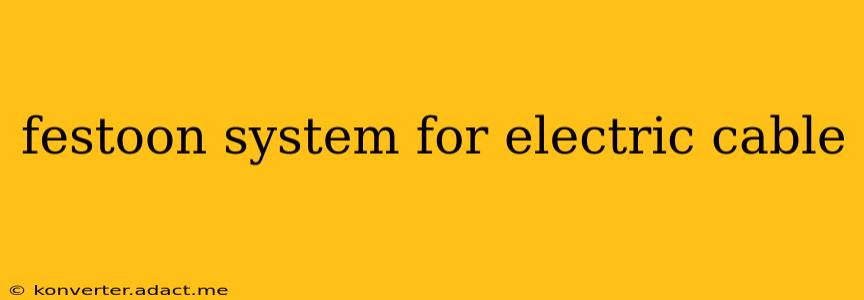Festoon systems provide a safe and efficient way to manage and protect electric cables in demanding industrial and commercial environments. They are crucial for applications where cables need to move freely, such as overhead cranes, gantry systems, and automated machinery. This guide delves into the intricacies of festoon systems, exploring their benefits, components, and considerations for choosing the right system.
What is a Festoon System?
A festoon system is a cable management system designed to support and protect electrical cables, pneumatic lines, and other flexible conduits during continuous movement. It essentially suspends cables along a track, allowing them to move freely without tangling, kinking, or experiencing undue wear. This prevents damage to the cables, reduces downtime due to cable failures, and enhances workplace safety.
What are the Different Types of Festoon Systems?
Several factors influence festoon system design and selection, leading to various types, including:
-
Horizontal Festoon Systems: These are the most common type, typically used for applications requiring linear cable movement. They're often seen in industrial settings with overhead cranes or conveyor systems.
-
Vertical Festoon Systems: Designed for vertical cable movement, these systems are less common but essential for specific applications like elevators or vertical transfer mechanisms.
-
Curved Festoon Systems: These systems can navigate bends and curves, providing flexibility in complex layouts. They are often customized to meet specific project needs.
-
Heavy-Duty Festoon Systems: Designed to withstand high loads and harsh environmental conditions, these systems are built for durability and long-term reliability in demanding applications.
What are the Key Components of a Festoon System?
Understanding the key components is vital to appreciating the system's functionality:
-
Cable Carriers/Trays: These hold the cables and protect them from damage. They are designed to allow for smooth cable movement and often feature features like internal separators to prevent cable chafing.
-
Track System: The supporting structure that guides the cable carriers. This can be made from various materials, including steel, aluminum, or high-strength polymers, depending on the application's demands.
-
End Stops/Terminals: These secure the cable carrier system at both ends, ensuring stability and preventing accidental detachment.
-
Suspension Hardware: Used to secure the track system to the ceiling or structure, ensuring stability and preventing sagging.
-
Wheels/Rollers: These allow the cable carriers to move smoothly along the track. The quality and design of the wheels significantly impact the system's lifespan and efficiency.
What are the Benefits of Using a Festoon System?
The advantages of festoon systems are numerous:
-
Increased Safety: Reduces the risk of electrical shocks and injuries associated with exposed or damaged cables.
-
Improved Efficiency: Prevents downtime caused by cable failures, leading to increased productivity.
-
Extended Cable Lifespan: Protects cables from abrasion, kinking, and other forms of damage, extending their operational life.
-
Better Cable Organization: Keeps cables neat, organized, and easy to access for maintenance or repair.
-
Cost Savings: Reduces repair and replacement costs associated with damaged cables and downtime.
How Do I Choose the Right Festoon System?
Selecting the right festoon system depends on several critical factors:
-
Cable Type and Weight: The system must be capable of supporting the weight and type of cables being used.
-
Movement Length and Speed: The system's length and capacity should match the application's requirements.
-
Environmental Conditions: The system must withstand the temperature, humidity, and other environmental factors present in the workspace.
-
Load Capacity: The system must be able to handle the total weight of the cables and carriers.
-
Durability Requirements: The system should be durable enough to withstand the expected wear and tear in the application.
How Much Does a Festoon System Cost?
The cost of a festoon system varies greatly depending on the factors mentioned above: size, materials, complexity, and features. A small, simple system could cost a few hundred dollars, while a large, complex, heavy-duty system could cost tens of thousands. Consult with a festoon system supplier for an accurate quote.
What are the Maintenance Requirements for a Festoon System?
Regular maintenance is crucial to ensure the longevity and safety of the system. This typically involves inspecting the track, wheels, and cables for signs of wear and tear and lubricating moving parts. Following the manufacturer's recommendations for maintenance is crucial.
What Safety Precautions Should Be Taken When Using a Festoon System?
Safety should always be the priority. This includes proper installation, regular inspections, and adherence to all safety guidelines provided by the manufacturer and relevant safety regulations.
By carefully considering these factors, you can choose and maintain a festoon system that ensures the safe and efficient operation of your equipment. This detailed guide provides a solid foundation for understanding and utilizing this vital cable management solution.
